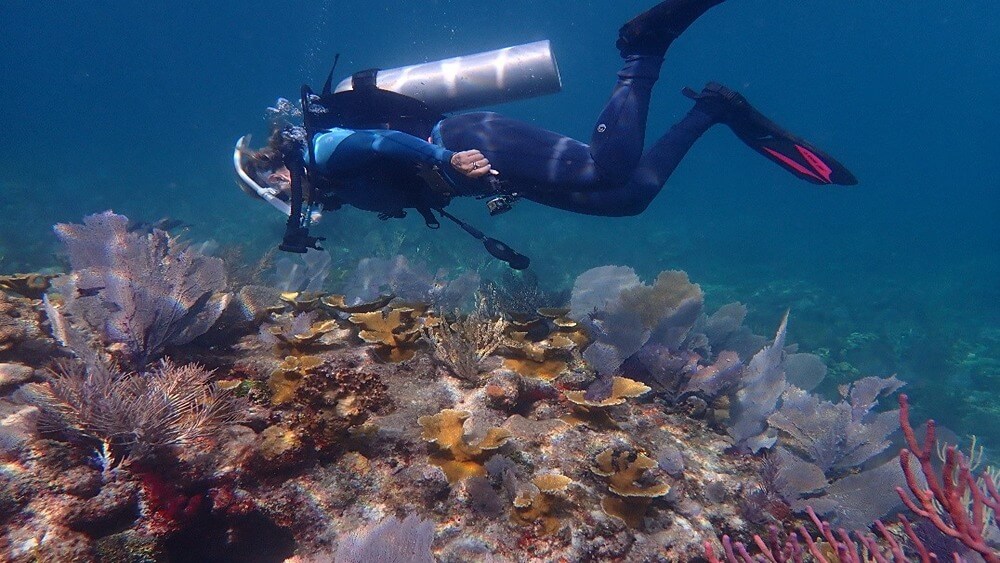Water Quality
Conservation Issue
Water quality in Florida Keys National Marine Sanctuary (FKNMS) is affected by local sources of pollutants and sediments, as well as regional and global stressors, sources, and inputs. Restoring and protecting water quality at all scales is essential for the overall recovery and sustainability of habitats, fish, and wildlife in the Florida Keys.

Description
Recognizing the importance of clean, clear water for the long-term health and survival of marine resources within the Florida Keys, Congress directed the establishment of a Water Quality Protection Program for FKNMS. This program is managed by an interagency steering committee that has worked for over 25 years to address sources of pollution through education and outreach, monitoring, research activities and a variety of corrective actions. The Water Quality Protection Program has had a number of successes at the local scale to improve water quality, including: providing oversight for wastewater and stormwater improvements, canal water quality restoration, eliminating vessel discharges, and implementing a variety of research and monitoring programs. Despite these efforts, poor water quality continues to affect marine resources in the Florida Keys. Sustaining and restoring healthy coral reefs, seagrass, and other habitats and the marine wildlife populations that utilize these habitats requires renewed efforts to understand and address the local, regional, and global sources of pollution that contribute to water quality degradation within the Florida Keys.
Data and Analysis Needs
- Nutrient and contaminant loadings from regional sources (Florida Bay, the Gulf of Mexico, and southeastern Florida) into waters surrounding the Florida Keys
- Effects of changes to the timing, quantity, and distribution of freshwater flows as a result of Everglades restoration on water quality and nutrient loading in FKNMS
- Effectiveness of corrective actions and other management activities in reducing local land-based sources of pollutants into sanctuary waters
- Current nutrient loading budget to nearshore waters by local sources (wastewater, stormwater, canals, etc.) and how it has changed over time
- Effectiveness of current water quality standards for protecting water quality, coral reefs, and other living marine resources in FKNMS
- Water quality parameter(s) and thresholds most appropriate for establishing a water quality standard specific to corals
- Extent and impact of endocrine disrupting compounds and other contaminants of emerging concern (CECs) within FKNMS, and corrective actions or technologies that could be implemented to reduce the scope and scale of these contaminants
- Effectiveness of existing wastewater and stormwater infrastructure in protecting water quality under changing climate scenarios; upgrades or alternative design features that might best promote infrastructure resilience and protect water quality
- Effectiveness of existing wastewater practices, including infrastructure, operations, and regulations, for protecting water quality in the unique Florida Keys environment
- Methods for improving effectiveness of outreach programs and messaging in inspiring water quality protection among residents and visitors in the Florida Keys
- Role of degraded water quality in recent isolated coral mortality and morbidity events; source and transport pathway for degraded water (e.g., Carysfort disease outbreaks and Biscayne Bay water; localized currents or upwelling)
- Effectiveness of targeted restoration activities in improving water quality; specific locations, certain organisms (e.g., sponges, oysters, or other filter feeders), and/or biomass that would maximize water quality benefits
- Relationships between nutrient loading and certain stressors, such as ocean acidification and warming, and whether these interactions can be used to inform restoration site selection
Potential Products
- Nutrient loading model for the Florida Keys
- Water quality model to evaluate how increases in freshwater flow (and potentially nitrogen loading) as a result of Everglades restoration may impact the coastal system and downstream coral reefs in the Florida Keys
- Incorporate new tools such as satellite imagery and continuous water quality monitoring stations into existing monitoring programs to provide real-time water quality information, capture episodic events, and detect regional inputs
- Revised water quality monitoring approach that is adaptable to evolving management needs; this may include identifying additional parameters, such as CECs, that should be incorporated into monitoring programs to better assess the composition and concentration of pollutants in FKNMS waters
- Revised water quality criteria that are protective of coral reefs
- Data visualization and decision support tool that collates water quality information from a variety of monitoring programs, is routinely updated, and allows resource managers and the public to quickly understand water quality patterns at different spatial scales
- Innovative education and outreach campaign to inspire community action to protect and restore water quality in the Florida Keys
For more information about this assessment, contact Karen.Bohnsack@noaa.gov.

